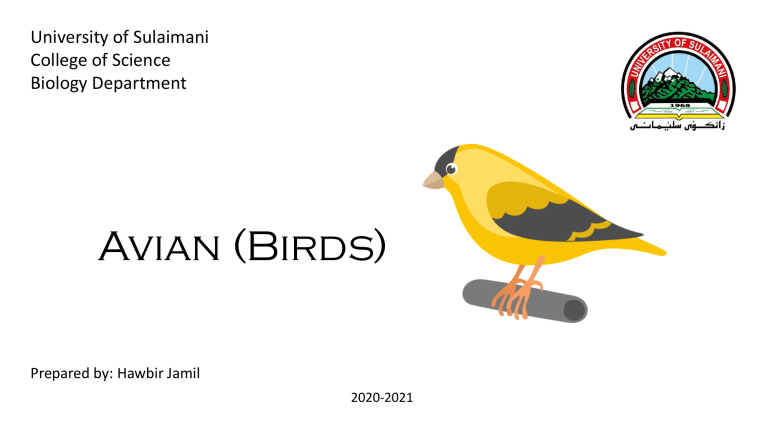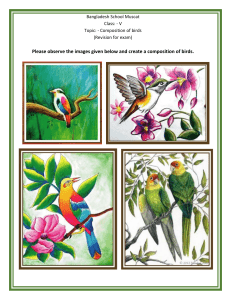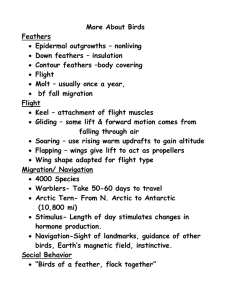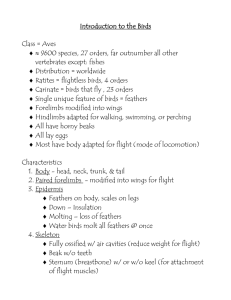Avian Biology: Bird Taxonomy, Evolution, and Systems
advertisement

University of Sulaimani College of Science Biology Department Avian (Birds) Prepared by: Hawbir Jamil 2020-2021 Outline • • • • • • • • • • • Taxonomy Evolutionary history of birds? Characteristics of birds? Feathers Skeleton Respiratory system Digestive system Circulatory, nervous and metabolic systems Reproduction Mating system Classification Taxonomy Phylum Chordata Subphylum Craniata (vertebrata) Superclass Tetrapods Class Subclass Superorder Amniotic tetrapods (Reptilian) Diapsida Archosauria Evolutionary history of birds? • Birds appeared in the Jurassic period. • Evolved from maniraptoran theropod dinosaurs about 150 million years ago. • first bird is archaeopteryx. • Over 10,000 identified species. • Most speciose of the land vertebrate classes. Characteristics of birds • Endothermic (homeothermic). • Have several different types of feathers that together keep “heat”. • Horny beak, no teeth • laying of hard-shelled eggs. • The forelimbs are modified to act as wings for flight, while the hind limbs are adapted to climb, perch, wade, or dive. • Only legs are covered with scales, usually with four toes on each foot. Characteristics of birds • Uropygial or oil gland is present in the tail region. • specialized uropygial gland in the tail, that essential to preening. • Birds perform internal fertilization. • high metabolic rate. • They are oviparous, and the matured female lay eggs with a large amount of yolk (telolacithal). • Birds are adapted to various modes of feeding due to the modified structures of beak: fruit-scooping, seedcrushing, fish-tearing. Feathers • A distinguishing feature of birds is feathers. • Feathers insulate birds from water and cold temperatures, flight control, camouflage, and important in selection of mating pairs • feather patterns and colors are part of the sexual dimorphism • Two types of flight feathers on the wings, Primary feathers are located at the wing tip and provide thrust, secondary feathers are located close to the body and provide lift. Skeleton • The bird skeleton include a boxlike trunk, short tail, long neck • The avian skeleton is highly adapted for flight, It is extremely lightweight, but strong enough to withstand the stresses that a bird experiences when taking off, flying and landing. • Many birds have hollow pneumatic bones rather than filled with tissue, which make flight easier, Not all bones of the skeleton are pneumatic. Respiratory system • well adapted for the high metabolic rate required for flight. • Avian respiration is an efficient system of gas exchange with air flowing unidirectionally. • A full ventilation cycle takes two cycles of inhalation and exhalation are needed to move a specific volume of air through the bird respiratory system. • First inhalation: air flows through the trachea and bronchi into the posterior air sacs. • First exhalation: air flows from the posterior air sacs to the lungs. • Second inhalation: air flows from the lungs to the anterior air sacs. • Second exhalation: air flows from the anterior sacs back through the trachea and out of the body. 1.inhalation 1.Exhalation 2. Inhalation 2. Exhalation Digestive system • digestive system extends from the mouth, through the pharynx, into the esophagus, into the stomach, through the small intestine and the large intestine, and out the cloacal opening. • Birds are often small with high energy needs, and for this reason they can digest food very quickly. • The high digestive rate helps young birds grow to maturity quickly • And migrating birds to put on the fat reserves that make their long flights possible. Circulatory, nervous and metabolic systems BIRDS HAVE FOURCHAMBERED HEARTS, AND A CIRCULATORY SYSTEM WITH BLOOD VESSELS. BECAUSE BIRDS HIGH METABOLISM REQUIRES RAPID CIRCULATION DUE TO QUICK BUILD UP OF WASTE PRODUCTS, AND NEED FOR OXYGEN. BIRDS GENERALLY HAVE EXCEPTIONAL VISION. WELL-DEVELOPED HEARING. POOR SENSE OF SMELL. Reproduction • Birds reproduce sexually and have separate sexes and internal fertilization. • Male and female birds have a cloaca (vent). serves as the bodily exit for their digestive, urinary, and reproductive systems. • Male does have two testes which become hundreds of times larger during the breeding season to produce sperm. • The female ovaries also become larger, although only the left ovary actually functions. Mating systems • Mating is generally preceded by courtship. • The three mating systems that predominate among birds are: Monogamy (having one partner for reproduction and raising the young). Polygyny (one male with more than one female) . polyandry (one female with more than one male). Subclass-1: Archiornithes Order: Archaeopterygiformes Subclass-2: Neornithes Classification Superorder-1: Odontognathae Superorder-2: Palaeognathae Superorder-3: Impennae Superorder-4: Neognathae Archiornithes • They were the most primitive and extinct fossil birds of the Jurassic period. • The jaws did not bear teeth. • Forelimb had three clawed digits. • They had a well-developed beak. • Archiornithes had a long feathered tail. • They had a small brain and eyes. • They had non-pneumatic bones and were capable less specialized for flight. • Archaeopteryx lithographica Neornithes • All the modern birds belong to the subclass Neornithes. • The representatives of this subclass first appeared in the Cretaceous period of the Mesozoic Era. • They have a well-developed sternum, which is usually keeled or carinate. • They do not bear long tail with no teeth on both jaws. In this case, teeth are replaced by horny rhamphotheca over the bill, but extinct forms had teeth. • The forelimbs become modified to wings. References • https://biologyeducare.com/aves/ • Cunnningham, E.J., 2001. Aves (birds). e LS. • Sibly, R.M., Witt, C.C., Wright, N.A., Venditti, C., Jetz, W. and Brown, J.H., 2012. Energetics, lifestyle, and reproduction in birds. Proceedings of the National Academy of Sciences, 109(27) • Harvey, S., Scanes, C.G. and Phillips, J.G., 1987. Avian reproduction. In Fundamentals of comparative vertebrate endocrinology (pp. 125-185). Springer, Boston, MA. • https://www.thespruce.com/how-do-birds-mate-386108 • https://www.newworldencyclopedia.org/entry/Bird#Anatomy_and_physiology • https://www.britannica.com/animal/bird-animal/Classification • https://www.birds.com/species/classifications/ • https://www.pnas.org/content/109/27/10937 • https://asknature.org/strategy/respiratory-system-facilitates-efficient-gas-exchange/



